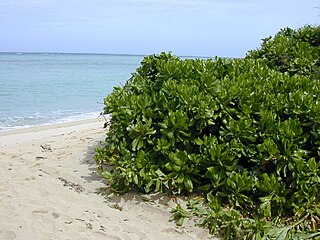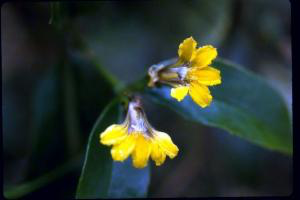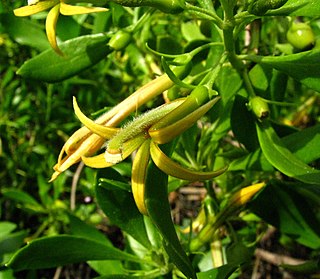
Scaevola is a genus of flowering plants in the Goodenia family, Goodeniaceae. It consists of more than 130 species, with the center of diversity being Australia and Polynesia. There are around 80 species in Australia, occurring throughout the continent, in a variety of habitats. Diversity is highest in the South West, where around 40 species are endemic.

Jasmine is a genus of shrubs and vines in the olive family of Oleaceae. It contains around 200 species native to tropical and warm temperate regions of Eurasia, Africa, and Oceania. Jasmines are widely cultivated for the characteristic fragrance of their flowers. Additionally a number of unrelated species of plants or flowers contain the word "jasmine" in their common names.

Pandanus tectorius is a species of Pandanus (screwpine) that is native to Malesia, Papuasia, eastern Australia, and the Pacific Islands. It grows in the coastal lowlands typically near the edge of the ocean. Common names in English include thatch screwpine, Tahitian screwpine, hala tree and pandanus. The fruit is edible and sometimes known as hala fruit.

Kīlauea Point National Wildlife Refuge is a National Wildlife Refuge on the northwest coast of the island of Kauaʻi in Hawaiʻi.

Iris lacustris, the dwarf lake iris, is a plant species in the genus Iris, subgenus Limniris and in the section Lophiris. It is a rhizomatous, beardless perennial plant, native to the Great Lakes region of eastern North America. It has lavender blue or violet-blue flowers, a very short stem and long fan-like green leaves. It is cultivated as an ornamental plant in temperate regions. It is closely related to Iris cristata.

Sesbania tomentosa, commonly known as Oahu riverhemp and ʻōhai, is an endangered species of plant in the pea family, Fabaceae, that is endemic to the main Hawaiian Islands as well as Nihoa and Necker Island. It inhabits low shrublands and, rarely, dry forests, at elevations from sea level to 2,500 ft (760 m). Associated native plant species include akiʻaki, ilima, naupaka kahakai, and pili. Off-road vehicles, wildfires, grazing, and alien species competition have destroyed their habitat on the main islands, but they are still quite common on Nihoa and Necker. At least 2000 specimens grow on Nihoa, while there are far less on Necker.

Mokoliʻi, also known as Chinaman's Hat, is a basalt islet in Kāneʻohe Bay, Hawaii. Mokoliʻi is part of Kualoa Regional Park and located 1⁄3 mile (0.54 km) offshore of Kualoa Point, Oahu. The 12.5-acre (5.1 ha) islet was at one time part of a basaltic ridge on Oahu before marine erosion separated it.

Moʻomomi is a Nature Conservancy preserve located on the northwestern shore of Molokaʻi in Hawaii. It was established in 1988. This area is dry and hot, primarily denuded of soil due to overgrazing and poor land use practices over the last 150 years.

Senna artemisioides, commonly known as silver cassia, is a species of flowering plant in the family Fabaceae and is endemic to Australia, where it is found in all mainland states and territories. It is a small, woody shrub with silver-green leaves and yellow flowers.

Brighamia rockii, known as the Molokai ohaha or Pua ʻala in Hawaiian, is a species of flowering plant in the bellflower family, Campanulaceae, that is endemic to the island of Molokaʻi in Hawaii. Pua ʻala inhabits mesic shrublands and forests on rocky cliffs from sea level to 470 m (1,540 ft) on the island's northern windward coast. Associated plants include ʻōhiʻa lehua, alaheʻe, lama, ʻūlei, and naupaka.

Plumeria rubra is a deciduous plant species belonging to the genus Plumeria. Originally native to Mexico, Central America, Colombia and Venezuela, it has been widely cultivated in subtropical and tropical climates worldwide and is a popular garden and park plant, as well as being used in temples and cemeteries. It grows as a spreading tree to 7–8 m (23–26 ft) high and wide, and is flushed with fragrant flowers of shades of pink, white and yellow over the summer and autumn.

Ericameria nana is a North American species of flowering shrub in the family Asteraceae known by the common names dwarf goldenbush and rubberweed. It is native to the western United States from eastern California, southeastern Oregon, Nevada, Idaho, Utah, and southwestern Montana.

The Hawaiian tropical low shrublands are a tropical savanna ecoregion in the Hawaiian Islands.

Kadua coriacea is a rare species of flowering plant in the coffee family known by the common name kioʻele. It is endemic to Hawaii, where it is known only from the island of Hawaiʻi and one individual remaining on Maui. It is a federally listed endangered species of the United States.

Scaevola taccada, also known as beach cabbage, sea lettuce, or beach naupaka, is a flowering plant in the family Goodeniaceae found in mangrove swamps and rocky or sandy coastal locations in the tropical areas of the Indo-Pacific. It is a common beach shrub throughout the Arabian Sea, the tropical Indian Ocean and the tropical islands of the Pacific Ocean.

Scaevola chamissoniana is a shrub in the family Goodeniaceae and its native range is the Hawaiian Islands, where it is known as the Mountain naupaka or Naupaka kuahiwi.

Scaevola enantophylla, commonly known as climbing fan-flower,is a species of flowering plant in the family Goodeniaceae and is endemic to Queensland. It is a scrambling vine with yellow fan-shaped flowers, and the only species in the genus with leaves arranged opposite.

Scaevola gaudichaudii, the ridgetop naupaka, is a shrub in the family Goodeniaceae. The flowers are yellow. The plant is endemic to Hawaii.

Scaevola gaudichaudiana, the mountain naupaka, is a perennial shrub in the family Goodeniaceae. The plant is endemic to Hawaii.

Scaevola parvifolia is an erect, many stemmed perennial in the family Goodeniaceae, which is native to Western Australia, the Northern Territory, Queensland and South Australia. It grows to a height of 0.6 m, and its blue-purple flowers may be seen from March to October.




















